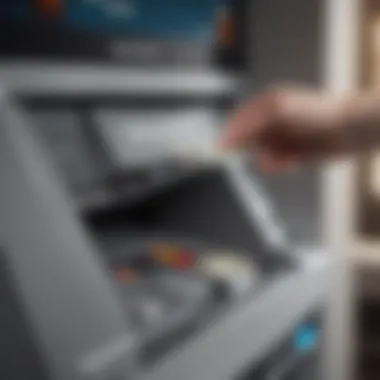Smart Ways to Withdraw Cash from Your Capital One Card


Intro
With the increasing number of credit card users, understanding how to extract money from a Capital One credit card can be crucial. Accessing cash through a credit card offers a convenient yet potentially expensive way to obtain funds. This section will shed light on several methods for getting money off a Capital One credit card, including cash advances, and specific strategies to do it wisely while minimizing potential pitfalls.
Understanding Budgeting
Effective budgeting plays an important role when dealing with credit cards. Knowing how much you can spend while maintaining a balanced budget and avoiding significant debt is essential.
Importance of Budgeting
A sound budget helps manage your finances. When you withdraw money from a credit card, orchestrating your repayment plan starts right at the budgeting step. Furthermore, without a budget, one risk falling into unnecessary debt due to unpredictable cash flows. Understanding the value of simple financial planning can save not only time, but effort and money as well.
Creating a Budget Plan
To create a budgeting plan, follow these steps:
- Assess your total income, including fixed salaries and any additional income sources.
- List all your monthly expenses, such as rent, bills, groceries, etc.
- Determine how much credit card cash advances you might realistically need.
- Aim to keep credit card spending within an established limit to guard against overwhelming interest.
Tracking Expenses
Tracking your expenditure is vital in adhering to your budget. Using simple worksheets can be beneficial to ascertain where your money goes each month. Capture daily expenses and fun events; these will add clarity to your financial health.
Budgeting Tools and Apps
Several apps and tools can facilitate the budgeting process:
- Mint
- YNAB (You Need a Budget)
- PocketGuard
These platforms allow you to monitor and manage your spending, thus killing the guessing game of where all your cash goes. They can support your efforts to avoid overspending, especially when thinking about cash advances.
Exploring Cash Advances
Getting money from a Capital One card often involves cash advances. Here we discuss cash advances, how one can get them, their practicality, and their costs involved. Remember, understanding what you are walking into will serve your financial interests well.
Cash advances are best theory you can adopt when needed cash is essential and no other funding is available. Simply stated, a cash advance will permit a user to withdraw from their credit card at an ATM.
- As of this date, some variables include:
- Most importantly:
- Limitations - Not every card allows cash advances.
- Lower credit limit for cash advances compared to what is available for purchases.
- The fees rarely; they're often comparative to a percentage of the cash advance or a flat-rate charge whichever is higher.
Basic future planning could prevent unwelcome expenses. Knowing about such facts tether back together the identified need for budgeting.
Always consider the implications of cash advances. Review your payment deadlines to manage costs effectively.
Prelude to Capital One Credit Cards
Capital One credit cards have become a popular choice among many individuals seeking convenience and financial flexibility. Understanding these cards is crucial for finding out how to withdraw money efficiently. They offer a variety of features tailored to a range of users, from students to small business owners. This part of the article will explore their key benefits, which include earning rewards, building credit history, and the flexibility in managing spending.
The importance of being well-informed about Capital One credit cards cannot be understated. Not only do these cards grant access to a line of credit, but they also present several options for cash withdrawals or advances that can aid in financial emergencies. It is vital to understand how these features work in practice, including any key considerations related to fees, access options, and overall management.
An informed approach to using Capital One cards means recognizing both their opportunities and their limitations. Learning how to best utilize these tools effectively might not just offer a short-term solution but also enhance long-term financial health by avoiding unnecessary costs.
Exploring the Features of Capital One Cards
Capital One offers a variety of credit card options each designed with unique features to cater different needs. Key options include:


- Rewards Programs: Cards specific bor cash back on purchases can help users accumulate rewards faster.
- No Foreign Transaction Fees: Paying abroad can be more economical with Capital One cards as many do not impose these fees.
- Credit Monitoring: Tools for monitoring one’s credit score can promote better financial habits.
Additionally, credit limits can be competitive, providing ample room for both emergency expenses and everyday purchases. Navigating through card specifics could potentially influence a person’s overall satisfaction with attention to service.
Understanding Cash Access Options
Knowing the diverse ways to extract funds from a Capital One credit card is pivotal. There are several accessible routes that one can take to obtain cash from their credit card balance:
- Cash Advances: A straightforward method, allowing users to withdraw cash from ATMs. However, it comes with particular fees and interest rates.
- Bank Withdrawals: Going directly to a bank branch for a cash advance can be another approach, though it may involve additional paperwork.
- Purchasing Gift Cards: Although indirect, buying gift cards for retailers could serve as a workaround to access cash, depending on the seller’s policies regarding such transactions.
This comprehensive understanding will help users make prudent choices when needing cash quickly. Capital One’s flexible cash access options should be compared against each other to maximize efficiency on withdrawals.
Cash Advances: Definition and Process
Understanding cash advances is crucial for anyone considering how to draw funds from their Capital One credit card. Cash advances allow quick access to cash that can be utilized in a variety of scenarios. However, one must remain cognizant of the implications, costs, and processes involved in this method of obtaining cash. This section unpacks the definition of cash advances and the steps required to initiate one, providing clarity and insight.
What is a Cash Advance?
A cash advance is the process by which a credit card holder can withdraw cash against their credit limit. Unlike regular credit card transactions, which are generally for purchasing goods or services, cash advances involve receiving cash directly. This method can be useful in emergencies or when immediate cash is essential.
Cash advances usually come with distinct terms compared to regular purchases. Here are key characteristics of cash advances:
- High Fees: Most credit cards impose a cash advance fee, often a percentage of the amount withdrawn.
- Interest Rates: The interest on cash advances often begins accruing immediately, unlike regular purchases which may have a grace period.
- Low Limits: Only a percentage of the total credit limit is usually available for cash advances.
Knowing what a cash advance entails helps in making informed choices about how and when to utilize this option.
How to Request a Cash Advance?
Requesting a cash advance from a Capital One credit card can be done in a few steps. Clarity on the procedure ensures a smooth transaction. Here are the basic steps:
- Check Your Credit Card Terms: Ensure that you understand your card's cash advance fees and interest rates by reviewing your credit card agreement.
- Locate an ATM: To withdraw cash, find an ATM that accepts your Capital One card. This can often be done using your smartphone to search for nearby locations.
- Use Your PIN: At the ATM, enter your credit card along with your Personal Identification Number (PIN), if you've set one. If unsure, you can create or retrieve a PIN by contacting Capital One customer service.
- Select Cash Advance: Choose the cash advance option on the ATM screen and enter the amount you wish to withdraw.
- Complete the Transaction: Follow the instructions to finalize the transaction. Be mindful of the cash advance fees displayed during the process.
- Keep Records: Always retain receipts for any cash advance transactions for your financial tracking purposes.
By understanding both what constitutes a cash advance and how to request one, consumers can make better decisions when accessing cash from their Capital One credit card. Proceeding with caution and full awareness of costs involved is paramount. Always remember, cash advances can lead to increased debt if not handled correctly.
Fees Associated with Cash Advances
Understanding fees related to cash advances on a Capital One credit card is vital for making informed financial decisions. Cash advances offer immediate access to cash, but they come with their costs. Evaluating these fees can prevent unanticipated financial strain in the future. Fees adherence not only befefits budgeting practices but also provides clarity on the total costs incurred during the borrowing process. Considering these fees into individual financial planning is key to avoiding potential pitfalls and steering clear of an increasing debt situation.
Understanding Cash Advance Fees
Cash advance fees can take several forms. Understanding the structure of these fees puts you in a better position to manage your credit usage wisely. Capital One typically charges either a flat fee for cash advances or a percentage of the amount of the advance—whichever amount is higher. This can vary from one card to another. Therefore, before requesting a cash advance, review your specific card agreement.
Typical cash advance fee structure includes:
- Flat fees: A common fee might be around $10 or more for each transaction taken from an ATM or through a bank.
- Percentage fees: You may find a fee of around 3% on a cash advance from a credit line, which can accumulate rapidly.
These fees could become considerable, especially if multiple cash advances are necessary within a short span. Keep in mind that cash equivalency may shift your overall credit utilization, potentially impacting your credit score.
Impact of Transaction Fees on Withdrawals
Every cash advance comes with transaction fees, impacting the amount you actually receive and keeping your financial situation in mind is instrumental. These charges decrease the actual cash amount needed for emergencies, like medical bills or unexpected repairs. Not accounting for this can alter your plans.
It is essential to factor these fees into your decision-making process. For example, if you are withdrawing $300, a 3% fee results in $309 to your principal, thereby increasing your repayment obligations.
“Fees can add up, darker than you first anticipate; staying informed leads to good financial practices.”
Instead of learning the hard way, consider alternatives. Assess methods of avoiding high fees like drawing a personal loan at a bank or credit union which could lead to more favorable conditions. Knowing the numbers in these financial choices will prevent unforeseen issues.
Understanding all costs associated with advances can help you make informed decisions and optimize your cash management strategy effectively.


Interest Rates on Cash Advances
Understanding interest rates on cash advances is vital for anyone considering this option with their Capital One credit card. Cash advances can provide immediate access to cash, but they often come with financial implications that demand careful consideration. Often, customers might overlook the costs linked with these advances. Such negligence can lead to substantial payments over time.
The interest rates applied to cash advances tend to be significantly higher than the rates for regular purchases. This increase can impact a user’s overall debt load, especially if they rely on cash advances frequently. Knowing these differences will influence your decision when choosing how and when to access money.
Comparing Interest Rates with Regular Purchases
Cash advance rates can be quite alarming when compared to typical purchase rates. Capital One, like many financial institutions, publishes a range for both types of interest. For instance, if a standard purchase APR is around 15%, you may find cash advance rates could reach upwards of 24% or more. This stark contrast can lead to unexpected tallies on your statements.
When analyzing the interest rates, a fundamental point of focus is the nature of cash withdrawals. Unlike typical purchases, where grace periods may apply, cash advances start accruing interest immediately. Therefore, if you’re choosing to pull funds, it’s crucial to realize that skipping the traditional approach can result in substantially heftier charges.
A summarized comparison can demonstrate just how it impacts your budgeting:
- Standard Purchase APR: Approximately 15%
- Cash Advance APR: Frequently 24% or higher
- Grace Period for Purchases: Oftentimes up to 30 days
- Cash Advance Interest Accrual: Immediate
Such particulars underline the importance of discerning when a cash advance may genuinely be necessary and worth the fee.
Calculating Potential Costs of Cash Advances
Assessing the costs linked to cash advances hinges on understanding how interest is accrued. Consider a scenario: You take a cash advance of $500 with an APR of 24%. Here is how it can play out if unpaid:
- Daily Interest Calculation: Divide the APR by the number of days in a year (365). For 24%, this equals about 0.0658% daily.
- Interest Accumulation: Multiply your outstanding amount by the daily rate. In this case, on day one, your accruing interest on $500 will be approximately $0.33.
- Monthly Compounding: Over 30 days, the total interest would tally around $10, giving you a clear picture if this is worth the cash access.
It's critical to consistently assess your financial habits and behaviors to measure whether the cash advance channel works best for you.
Be mindful of how quickly the costs can pile up.
Depending on how much you intend to recover, performing this step of calculation could reveal a more prudent way to access cash in some situations.
Key takeaway: Always examine applicable interest rates and associated costs before obtaining a cash advance on your Capital One credit card. Ignoring these points might lead to unnecessary dent in your finances.
Alternative Methods for Accessing Cash
Accessing cash through a credit card isn't solely confined to traditional cash advances. This section delves into innovative and efficient methods for obtaining funds from a Capital One credit card. These methods offer flexibility and potential cost savings, appealing particularly to young professionals, students, and small business owners who may need to harness their credit options carefully.
Using a Credit Card to Pay Bills
One convenient strategy involves using your Capital One credit card to settle everyday bills. Many service providers accept credit card payments, allowing for unique cash flow management. Paying bills, such as utilities or insurance, with your credit card enables you to maintain liquidity while also potentially earning rewards. However, do notice that some companies might charge extra fees and not all allow credit card payment. Careful exploration can help you to find which services do accept credit cards.
- Benefits:
- Keep cash in pocket: Using credit allows you to delay actual cash outpour.
- Earn more rewards: Each payment counts towards possible cashback or points.
- Convenient tracking: Credit card statements simplify budget tracking.
Ensure that while employing this method, repayments align visibility with your budgeting habits to avoid overspending.
Peer-to-Peer Payment Options
Peer-to-peer payment platforms have gained significant traction as a robust alternative if direct cash withdrawals don’t fit your needs. Applications like Venmo and PayPal enable users to send money directly using their credit card for a minimal fee. You can fund transactions this way which provides easy access to cash.
- Process:
- Download the application of your choosing.
- Link your Capital One credit card which often incurs a fee for the transaction but is generally lower than standard cash advances.
- Transfer funds to your account, making it an immediate access to cash.
One crucial consideration is the associated fees with this method. Using the credit card to fund transactions usually will involves a transaction fee that may impact the return on this cash access method.
Utilizing Cashback Offers
Many credit cards provide cashback features. These can be an effective route for obtaining some cash through your credit card usage. Credits earned can effectively reduce your payment amount or even put cash back into your account over time. Explore offers and promotional programs of your Capital One card because some may augment your cashback rates temporarily or for specific purchase categories.


- Strategies to leverage cashback:
- Always check which categories yield reloadable cashback, and plan for maximum earnings.
- Pay attention to promotional periods, where cashback rewards increase.
- Regularly review your accumulated cashback for potential “on-demand” withdrawals with qualifying thresholds.
Cashback can function as a unique way to progressively compound your savings or make necessary purchases providing directly accessible funds as needed. Keep in mind how you manage these transactions aligns with your main financial strategy to maintain healthy credit metrics.
Always approach financial decisions with a clear understanding of the terms to avoid unnecessary impacts against your overall financial landscape.
Utilizing alternative methods for accessing cash from a Capital One credit card can provide a versatile approach to strengthening your financial status. It’s crucial to analyze each method with respect to your personal financial habits, to ensure that you maximize benefits while minimizing downfalls.
Best Practices for Cash Management
Cash management is crucial when it comes to utilizing a Capital One credit card for withdrawing funds. Following best practices ensures that you can access necessary cash while minimizing financial risk. Developing a thorough understanding of these practices can lead to a more consistent approach towards managing credit and expenses. Here, we expore two key subtopics that can aid individuals in effectively managing cash withdrawals.
Setting a Budget for Withdrawals
Creating a budget specifically for cash withdrawals is a key strategy to maintain control over your finances. It is vital to identify how much cash you will realistically need and establish limits according to your income and expenses. Here is how to set an effective budget:
- Assess Your Needs: Start by evaluating your monthly expenses. Determine how often you will need cash. Categories may include groceries, dining, or occasional bills.
- Include Cash in Overall Budget: Allow room for cash withdrawals within broader budget allowances. This prevents excess outflows. For instance, if your regular budget is $400 per month for groceries, you might allot $100 for cash from your credit card for other necessities.
- Track Your Withdrawals: It’s helpful to document each cash advance. Tracking helps ensure spending falls within your set budget limits. Consider using personal finance apps to stay on top.
- Revise Regularly: Check your budget monthly. Adjust when necessary. As financial needs change, there may be a need for more or less cash in future months.
Setting a defined budget provides a framework for responsible cash management, which is essential with credit insights in mind.
Monitoring Spending to Avoid Debt
Monitoring your spending habits is another important practice for comprehensively managing cash obtained from a Capital One credit card. Accumulating debt can happen unexpectedly, particularly with cash advances. These practical steps can help you navigate this situation effectively:
- Review Account Statements: Regularly reviewing your credit card statements gives insight into cash withdrawals and overall spending. Unveil trends; are you using cash to cover necessary expenses of just impulsive purchases?
- Set Alerts: Utilize smartphone notifications to set spending thresholds. Alerts can keep you informed when you hit certain limits, which is helpful for avoiding overspending.
- Analyze Needs vs. Wants: Before withdrawing cash, pause to find whether it's a necessity. Assess needs critically—this ensures your cash use promotes effective outcomes.
Monitoring spending and consistently evaluating your habits is the key. It aids in understanding how withdrawals impact overall financial health.
In summary, adopting effective cash management practices paves the way for responsible credit behavior. Balancing budgets and monitoring expenses allows you to enjoy the benefits of having access to cash while mitigating the risks associated with excessive debt.
Understanding the Risks of Cash Advances
Understanding the risks of cash advances is a critical aspect when deciding to use a Capital One credit card for immediate cash needs. While accessing cash may seem appealing due to convenience, it can lead to significant financial consequences if the potential risks are not thoroughly considered. Utilizing cash advances can affect both your wallet and your credit in several important ways.
Potential for Increased Debt
Taking out a cash advance may initially solve a cash crunch but can quickly escalate into a cycle of debt. Cash advances often involve fees that are much higher than regular purchases, leading to immediate financial strain. Borrowers should be mindful that interest on cash advances starts accumulating immediately, unlike typical purchases where a grace period may apply.
High fees and instant accrued interest create a heavy financial burden. If the borrowed amount is not paid back swiftly, the unpaid debt grows rapidly. Understanding your limits and evaluating your repayment strategy before proceeding with a cash advance is crucial. Things can get out of hand if the repayments are not adequately managed, possibly resulting in overspending and prolonged debt.
As an example, Capital One may charge an upfront cash advance fee and a higher interest rate on that amount. This leads to a significantly larger total repayment amount than originally expected. Debtors could find themselves in a situation where they cannot meet their repayment obligations on time, requiring them to borrow again, thus compounding their debt and financial dilemma.
Impact on Credit Score
The impact of cash advances extends beyond immediate debt levels; it also influences your credit score. Credit utilization is a significant factor in calculating your score, and cash advances can cover they they generally count towards this limit even if they come from a credit card. Although it's not reflected as an increase in utilization until late on payments or missed payments occurs, frequent cash withdrawals can signal financial distress to creditors.
If a consistent pattern of cash advances emerges, lenders may perceive you as a high-risk borrower. This may affect your ability to secure financing in the future, influencing lending terms that may be offered or resulting in outright rejection. Even one misunderstood cash advance can lead to missed payments if the orking can't cover the incoming debt effectively.
Important Note: Managing cash utilization carefully is critical for maintaining a good credit score. Regularly borrowing cash through advances might unintentionally lead to a sudden drop in your credit rating.
Recognizing these risks is essential in making informed decisions. Financial actions, especially those involving cash advances, require short-term and long-term assessments. Each choice has possible ramifications that should align with your broader financial strategy.
Closure: Making Informed Decisions
In this article, making informed decisions is emphasized. Understanding how to withdraw money from a Capital One credit card brings important aspects to light. With cash advances and alternative methods available, knowing the right choice can greatly influence one's financial health.
Every individual has different financial needs. It is vital to evaluate which facorts matter most before any transactions. Assessing one’s monthly income, expenses, and long-term goals helps identify the need for cash withdrawal. Furthermore, evaluating the fees and interest rates associated with cash advances offers substantial insight into the total cost of accessing funds.
Another essential consideration is balancing needs with expenditures. Finding this balance can lead one to the most effective strategies for using a credit card as a means of funds. Therefore, monitoring one’s spending and staying within a designated budget are advisable practices for young professionals, students, and small business owners alike.
Remember, taking cash from a credit card is not just about the transaction; it involves various implications.
Ultimately, making informed decisions requires one to focus on the short terms reality while keeping in mind long-term goals. Continuous assessment of your financial situation helps ensure that each decision positively impacts overall financial wellbeing.



